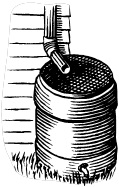 Learn to Harvest Rainwater - June 6, 2012 Jeff Schalau, Agent, Agriculture & Natural Resources University of Arizona Cooperative Extension, Yavapai County Residential water harvesting methods vary from simple earthworks designed to divert and catch surface runoff on the land surface to complex systems that collect water from roofs and other surfaces, direct it to storage tanks, and pump it to its destination. To begin rainwater harvesting, you must consider seasonal rainfall patterns, topography of your property, roof catchment area, water requirements of your landscape or garden, water storage (in soil or tanks), and your budget. For the most part, Verde Valley soils are course textured enough to allow adequate infiltration, but fine textured enough to store a substantial amount of water. To be successful, there are two other considerations: 1) plant roots are present and well distributed in the areas where the harvested water is being applied, and 2) the plants you are irrigating are actively growing and able to use the harvested water. Passive rainfall harvesting systems rely on manipulation of topography and smart design. Earthworks such as berms or swales can be constructed from soil to create areas where water is diverted and/or collected for direct infiltration. On flat ground, you could create lower elevation basins in areas to collect harvested water. On a slope, berms should be crescent-shaped, higher in the center than the edges, and formed where they will catch surface runoff coming down the slope. If you are considering paving an area, think about using pervious pavement to allow infiltration of some water and directing excess to basins. Permeable pavements allow water to infiltrate through or in between the paving material. Paving materials such as brick or concrete pavers and flagstone can be set in sand rather than concrete to allow water to enter the soil if desired. There are also pervious concrete mixes that contain coarse aggregate and little or no sand. This strategy also increases oxygen availability under the paving for healthier plant roots. The potential volume of water available for harvest can be realized by knowing the relationship between inches of rainfall and volume of water: one inch of rainfall equates to 0.62 gallons per square foot of horizontal surface area. For instance, given the average city lot (1/4 acre or 10,890 sq ft) and average rainfall (12 inches/year for the Verde Valley), this yields 81,021 gallons of water (7.48 gal./cubic ft). In reality, it is impractical to capture or redirect all this water for use by plants or people. However, this does provide you with some idea of the shear amounts of water that are moving through your landscape. Household water harvesting systems commonly utilize the roof of the home and other buildings as a collection surface. You can collect 600 gallons of water per inch of rain from 1,000 square feet of catchment surface. Here, water is collected via rain gutters, downspouts and collection pipes which are diverted into a storage container. The simplest and least expensive storage containers are plastic barrels. Two or more containers can be connected with PVC pipe that allows water to flow from one barrel to the next. Steps should also be taken to seal the barrel to limit access to mosquitoes and small animals that could fall in and drown. There are also specially designed downspout filters and other accessories to improve water quality and harvesting efficiency. More complex water harvesting systems utilize larger storage tanks to store harvested water. The tank can be above or below ground (cistern). You can use commercially purchased water tanks or home-built tanks constructed from a corrugated steel culvert set upright in concrete. The advantage to the above ground cistern is that gravity can be used to direct water to areas where irrigation is needed. To learn more, attend the free rainwater harvesting workshop presented by the University of Arizona Cooperative Extension on June 9 between 9 am and noon at the Cottonwood Recreation Center, 150 S 6th St., Cottonwood. Several topics will be covered including: passive and active systems, plants and soils, basic calculations, design, equipment, historic applications and water rights. Links to more information are also included below. Follow the Backyard Gardener on Twitter – use the link on the BYG website. If you have other gardening questions, call the Master Gardener help line in the Camp Verde office at 928-554-8999 Ext. 3 or e-mail us at cottonwoodmg@yahoo.com and be sure to include your name, address and phone number. Find past Backyard Gardener columns or provide feedback at the Backyard Gardener web site: http://cals.arizona.edu/yavapai/anr/hort/byg/. Harvesting Rainwater for Landscape Use (University of Arizona Cooperative Extension) http://ag.arizona.edu/pubs/water/az1052/harvest.html Rainwater Harvesting (Texas A & M AgriLife Extension) http://rainwaterharvesting.tamu.edu/rainwater-basics/ |